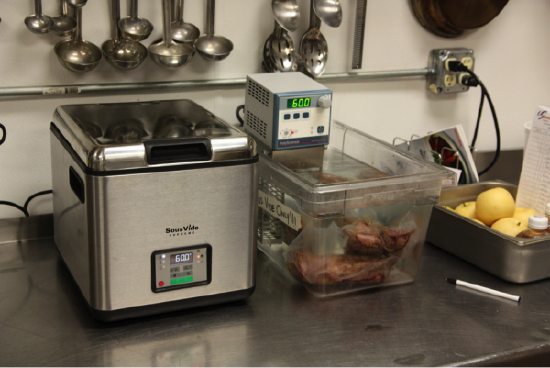1.9: Low-temperature and sous-vide
- Page ID
- 93178
Sous-vide cooking is about immersing a food item in a precisely controlled water bath, where the temperature of the water is the same as the target temperature of the food being cooked. Food is placed in
a food-grade plastic bag and vacuum-sealed before going into the water bath. Temperatures will vary depending on desired end result. This allows the water in the bath to transfer heat into the food while preventing the water from coming into direct contact with it. This means the water does not chemically interact with the food: the flavors of the food remain stronger, because the water is unable to dissolve or carry away any compounds in the food (Figure 1).
Figure 1. “Img_0081” by Derek is licensed under CC BY- SA-ND 2.0
Sous-vide fruits and vegetables
Cooking vegetable and fruits sous-vide is a great way to tenderize them without losing as many of the vitamins and minerals that are normally lost through blanching or steaming. Fruits can also be infused with liquid when cooked at lower temperatures by adding liquid to the bag. Sous-vide helps preserve the nutrients present in fruits and vegetables by not cooking them above the temperatures that cause the cell walls to fully break down. This allows them to tenderize without losing all their structure. The bag also helps to catch any nutrients that do come out of the vegetable.
While time and temperature do not factor into safety for fruits and vegetables, they do have a unique effect on their structure. There are two components in fruits and vegetables that make them crisp: pectin and starch. Pectin, which is a gelling agent commonly used in jams and jellies for structure, breaks down at 83oC (183oF) at a slower rate than the starch cells do. In many cases this allows for more tender fruits and vegetables that have a unique texture to them.
Custards
The term custard spans so many possible ingredients and techniques that it is most useful to think of a custard as simply a particular texture and mouth feel. Custards have been made for centuries by lightly cooking a blend of eggs, milk, and heavy cream, but modernist chefs have invented myriad ways to make custards.
Using the sous-vide method to prepare crème anglaise, curds, ice cream bases, custard bases, sabayons, and dulce de leche is possible. The technique offers greater consistency and more control over the texture, which can range from airy, typical of a sabayon, to dense, as in a posset. For custards, eggs will be properly cooked at 82°C (180oF), so if the water bath is set to this temperature, no overcooking can happen. The one constant among custards is the use of plenty of fat, which not only provides that distinctive mouth feel but also makes custard an excellent carrier of fat-soluble flavors and aromas. Lighter varieties of custard, prepared sous-vide style and cooled, can be aerated in a whipping siphon into smooth, creamy foams.
Other applications for vacuum-seal processes
Fruit compression
Vacuum-compressing fruits and vegetables is a popular modern technique that can give many plant foods
an attractive, translucent appearance (as shown in the watermelon in Figure 2) and a pleasant, surprising texture. This technique exploits the ability of a vacuum chamber to reduce surrounding pressure, which causes air and moisture within the plant tissue to rapidly expand and rupture the structures within the food. When the surrounding pressure is restored to a normal level, the labyrinth of air-filled spaces collapses. As
a result, light tends to pass through the food rather than being scattered and diffused, which is why vacuum-compressed plant foods appear translucent. Causing the porous structure of a plant food to collapse also imparts a somewhat dense, toothsome texture that can give a familiar ingredient, such as watermelon, an entirely new appeal.
Figure 5. “WD-50 (7th Course)” by Peter Dillon is licensed under CC BY 2.0
Infusions
When adding liquids, the vacuum-seal process creates a rapid infusion—especially with more porous foods (such as adding spices to cream or herbs to melon). This can add flavor and texture in a shorter time than traditional infusions.




